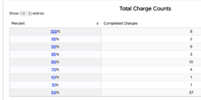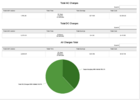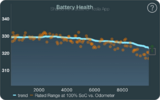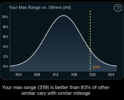I read and read and read about everyones battery degradation so I adopted a battery charging strategy in hopes of being "that guy" who defied the odds. Seems I was unsuccessful.  . Oh well, I tried. Here is how things stand after 10k miles.
. Oh well, I tried. Here is how things stand after 10k miles.
I drive a MYLR with a rated range of 330 miles.
I've owned the car for 8 weeks and have been averaging 1250 miles per week. My average will fall, but not by a lot. Long term I believe I'll average about 800 miles per week.
When I get home I usually have less than 20% battery. I immediately charge to 50% well the battery is still warm. Then I let it rest at 50% until the next time I need to travel. Usually less than 36 hours. I will then set it to be charged by my departure time. Occasionally I can leave the house with only 70% charge, but most of my trips I need 90-100% charge to avoid using a supercharger. Usually I can get home without supercharging, but sometimes I need to stop for a 10 minute charge. So I am actively trying to keep the charge below 80%. When it does get a full charge I drive immediately and get it back to 80% or below in about an hour. I don't charge over 80% at super chargers typically. So I would tell you that the car has had a charge of more than 80% for only 25 hours of its life.
I did take a 3,000 mile vacation that was exclusively superchargers, but other than thank I charge mostly at home.
So, as best I can tell, here is what it has done to my battery (it's not as good as I hoped, but I'm still satisfied, and I LOVE the car.)
Testify says I've lost 3.88% or about 13 miles. Up until about 8,000 miles it looked like I was beating "the system" but then shortly after that I dropped down to where everyone else was.

If anyone is interested in the charge levels this screen grab shows how many times I charged to various percentages.

And lastly, the breakdown of home charging vs supercharging. This shows 38% at superchargers, but that will go down. That was skewed by the 3,000 mile vacation. Going forward I estimate I'll supercharge less than 15%. 85% at home. Total cost of electricity for 10k miles was $641.18. Supercharging was WAY more expensive than charging at home. Just in case there are any newbies out there that expect to supercharge for free (oddly that's the most frequent comment I get about superchargers "oh, they aren't free?)

For those of you who know "batteries" does degradation come from time? Miles? Usage? In other words, have I sped up the degradation by so many miles in such a short amount of time, or is that irrelevant?
p.s.
I run the IOS App STATS. It gives similar information. It puts me at a range of 319 miles or a loss of 11 miles range. A loss of about 3.33%


I drive a MYLR with a rated range of 330 miles.
I've owned the car for 8 weeks and have been averaging 1250 miles per week. My average will fall, but not by a lot. Long term I believe I'll average about 800 miles per week.
When I get home I usually have less than 20% battery. I immediately charge to 50% well the battery is still warm. Then I let it rest at 50% until the next time I need to travel. Usually less than 36 hours. I will then set it to be charged by my departure time. Occasionally I can leave the house with only 70% charge, but most of my trips I need 90-100% charge to avoid using a supercharger. Usually I can get home without supercharging, but sometimes I need to stop for a 10 minute charge. So I am actively trying to keep the charge below 80%. When it does get a full charge I drive immediately and get it back to 80% or below in about an hour. I don't charge over 80% at super chargers typically. So I would tell you that the car has had a charge of more than 80% for only 25 hours of its life.
I did take a 3,000 mile vacation that was exclusively superchargers, but other than thank I charge mostly at home.
So, as best I can tell, here is what it has done to my battery (it's not as good as I hoped, but I'm still satisfied, and I LOVE the car.)
Testify says I've lost 3.88% or about 13 miles. Up until about 8,000 miles it looked like I was beating "the system" but then shortly after that I dropped down to where everyone else was.
If anyone is interested in the charge levels this screen grab shows how many times I charged to various percentages.

And lastly, the breakdown of home charging vs supercharging. This shows 38% at superchargers, but that will go down. That was skewed by the 3,000 mile vacation. Going forward I estimate I'll supercharge less than 15%. 85% at home. Total cost of electricity for 10k miles was $641.18. Supercharging was WAY more expensive than charging at home. Just in case there are any newbies out there that expect to supercharge for free (oddly that's the most frequent comment I get about superchargers "oh, they aren't free?)

For those of you who know "batteries" does degradation come from time? Miles? Usage? In other words, have I sped up the degradation by so many miles in such a short amount of time, or is that irrelevant?
p.s.
I run the IOS App STATS. It gives similar information. It puts me at a range of 319 miles or a loss of 11 miles range. A loss of about 3.33%




